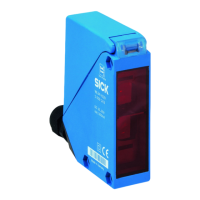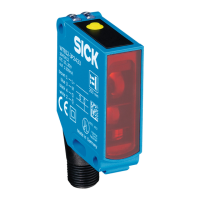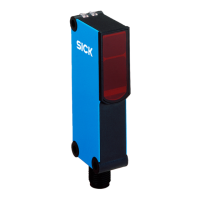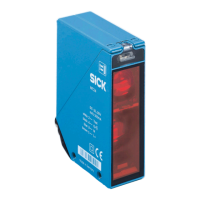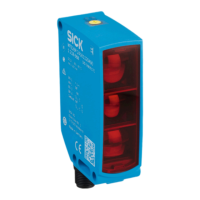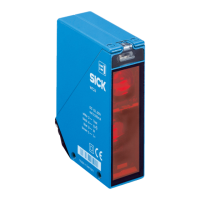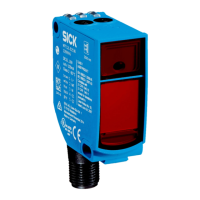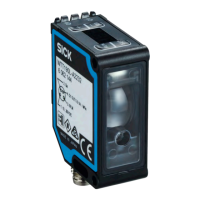LED/fault pattern Cause Measures
Yellow LED lights up, no object in the path
of the beam
When using a proximity fiber:
•
Switching point is set to a too low
value (or too large sensing range)
•
Reflectivity of the background too
high
•
Manually configured parameter set‐
tings different to the default
•
The light beam of a proximity fiber
hits the receiver of another (neigh‐
boring) proximity fiber
When using through-beam fibers:
•
Switching point is set to a too high
value (or too short sensing range)
•
Manually configured parameter set‐
tings different to the default
•
The light beam of a through-beam
fiber hits the receiver of another
(neighboring) through-beam fiber
When using a proximity fiber:
•
Increase the switching point
•
Decrease the reflectivity of the back‐
ground
•
Set the detection mode to “Proxim‐
ity” and set the digital output to “Not
inverted”
•
Use bus modules with anti-interfer‐
ence function to avoid mutual inter‐
ference
When using through-beam fibers:
•
Decrease the switching point
•
Set the detection mode to “Through-
beam” and set the digital output to
“Not inverted”
•
Use bus modules with anti-interfer‐
ence function to avoid mutual inter‐
ference
•
Change the arrangement of the
sender and receiver for every sec‐
ond through-beam fiber, or maintain
an adequate separation between the
through-beam fibers.
Object is in the path of the beam, yellow
LED does not light up
When using a proximity fiber:
•
Distance between sensor and object
is too large or switching point is set
to a too high value (or too small
sensing range)
•
Manually configured parameter set‐
tings different to the default
When using through-beam fibers:
•
(Transparent) object has a too high
transmission, or the switching point
is set to a too low value
•
Manually configured parameter set‐
tings different to the default
•
Reflection on strongly reflecting sur‐
faces
•
Insufficient transmission of the
fibers (e.g., fiber breakage)
When using a proximity fiber:
•
Decrease the switching point
•
Set the detection mode to “Proxim‐
ity” and set the digital output to “Not
inverted”
When using through-beam fibers:
•
Increase the switching point
•
Set the detection mode to “Through-
beam” and set the digital output to
“Not inverted”
•
Change the position of the fiber or
reduce the reflectivity of the reflec‐
tion surface
•
Replace the fiber
Signal interruptions when object is
detected
Difference between the switch-on and
switch-off threshold (=hysteresis value)
is too small, or the fluctuation of the
light reflected by the object is too large
for the configured hysteresis value.
Increase the hysteresis value
68
O P E R A T I N G I N S T R U C T I O N S | WLL80 Analog 8027947 /2022-12-14 | SICK
Subject to change without notice

